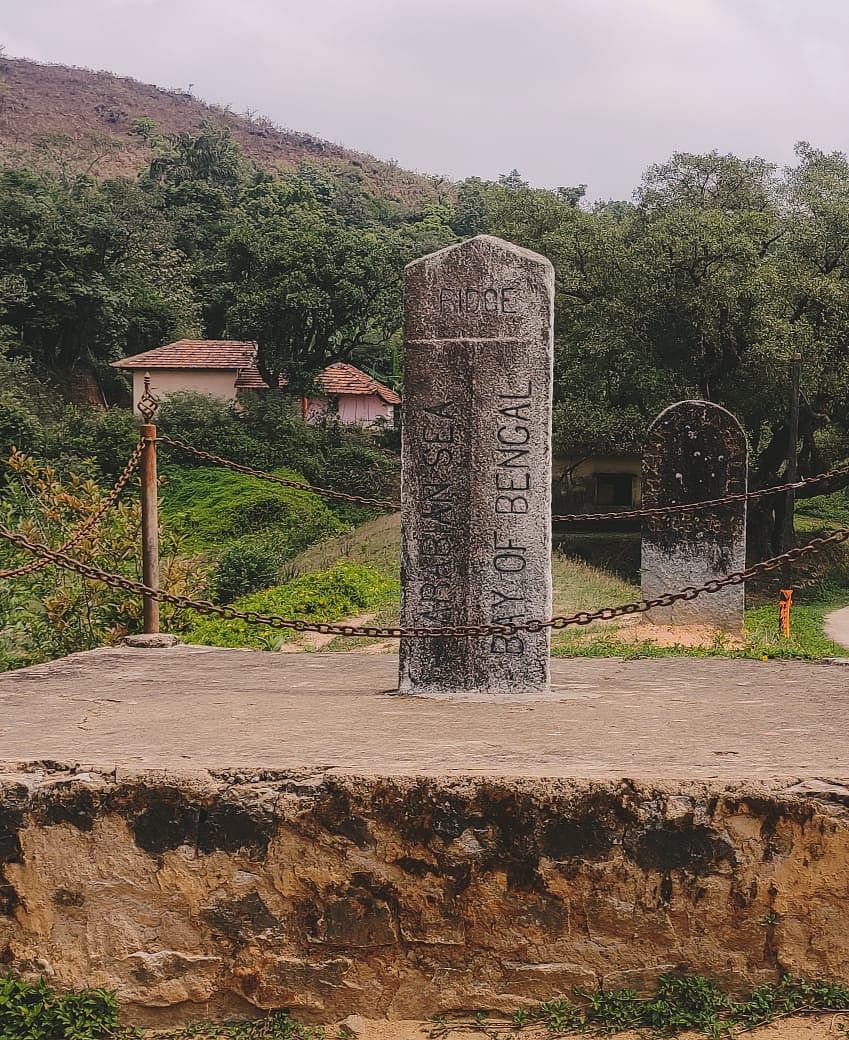

There is more to Sakleshpur than hills, resorts, and coffee and spice plantations, I learned on a road trip recently.
Two bikers and a family bundled in a car stopped by Mankanahalli, a small village along the Bisle Ghat, and started clicking photos of a stone slab on the roadside. Weathered and about three feet high, it looked ordinary except for the plinth it was erected on and the chain that barricaded it from four sides. I was more intrigued by the long-legged white birds and the lush grass dotting the lake close by.
That stone was a geographical marker, I would gather.
It denotes a local ridge in the background that divides the rainwater between the Arabian Sea and the Bay of Bengal. That is, the water flowing westwards joins the Netravati and Sharavati rivers before draining into the Arabian Sea while the east-flowing water joins the Hemavathy river catchment and the Kaveri river before ending in the Bay of Bengal. These directions are etched on the stone.
It is believed the marker was installed by the British but when and why – the residents of Mankanahalli we spoke to could not tell. But they let us in on their internal joke. Shashi Kumar, who works as a gram panchayat officer, quipped, “My house is on the Bay of Bengal side.” His friend, who works in the revenue department and who did not want to be named, laughed as he said, “My house is in the centre, neither right nor left of the ridge!”
We turned to Ashok Hanjagi, professor and chairman, geography and geoinformatics department, Bangalore University, for insights.
These water-dividing ridges are aplenty in the Western Ghats, of which the Bisle Ghat is a part, and the world over, he began. A ridge is the highest point in any topography or on a chain of continuous mountains and hills and, hence, it naturally splits the rainwater.
These ridges are common on the western side of the Western Ghats. They run parallel to the west coast, from the Cardamom Hills (or Yela Mala) in Kerala up to the south of Gujarat for 1,600 km, and tower mostly between 500 and 1,200 metres.
“The western side has high ridges. They face the monsoon winds and have more cloud formation, high rainfalls, and evergreen, dense forests with higher canopies. The eastern side has gentle slopes and lesser greenery,” he says.
The rivers draining into the Arabian Sea have more water discharge because they receive more rainfall and have a shorter distance to travel. “More hydroelectric power stations are on this side,” Ashok points out. On the contrary, the east-flowing rivers are harvested for dam, irrigation and drinking purposes along the way. So they drain lesser water into the Bay of Bengal.
There is nothing extraordinary about these ridges or commemorative stones, he said on repeat. At 1,925 metres, even Mullayanagiri, the highest peak in Karnataka, is a water divider and so is Doddabettahalli, a village within Bengaluru city limits that is set atop the Deccan plateau at an elevation of 962 m, he gives examples.
If water-dividers are so ubiquitous, then why stone markers are not commonly seen? “It could be a matter of accessibility. Wherever the British found it possible to install a marker (in India), they would have. Some ridges are high and deep inside the forests and difficult to reach,” he surmises.
Why did the British commemorate the ridges? Ashok says this with a laugh, “Oh! The British loved measuring the topography – from land to mountains and deep oceans, and from elevation to rivers and settlements. Since they hailed from the cold country, they loved high places like the Baba Budan and Nandi Hills in Karnataka and mapping helped them identify these sites.”
He is quick to acknowledge that most mappings were done to further conquest plans in the sub-continent spanning Burma and Sri Lanka, a fact widely known. “These surveys must have taken tens of years to conduct and they became available to us in the 1960s-70s,” he believes.
No one, neither the assistant commissioner of Sakleshpur nor the forest officers or the staff of the archaeological department they spoke to on my behalf, knows who installed this geographical marker and when. If only stones could speak.